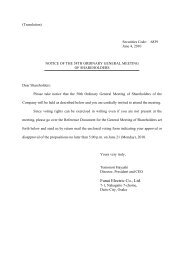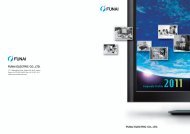Annual Report 2012 [PDF:5300KB] - FUNAI Global
Annual Report 2012 [PDF:5300KB] - FUNAI Global
Annual Report 2012 [PDF:5300KB] - FUNAI Global
You also want an ePaper? Increase the reach of your titles
YUMPU automatically turns print PDFs into web optimized ePapers that Google loves.
e. Allowance for Doubtful Accounts—The allowance for doubtful accounts is stated in amounts considered to be appropriate based on<br />
the companies’ past credit loss experience and an evaluation of potential losses in the receivables outstanding.<br />
f. Inventories—Inventories of the Company and its consolidated domestic subsidiaries are mainly stated at the lower of cost, determined<br />
by the average method for finished products and work in process, and by the first-in, first-out method for raw materials, or net selling<br />
value.<br />
Inventories of the consolidated foreign subsidiaries are mainly stated at the lower of cost, determined by the first-in, first-out method,<br />
or net selling value.<br />
g. Investment Securities—Investment securities are classified and accounted for depending on management’s intent. All investment<br />
securities are classified as available-for-sale securities.<br />
Marketable available-for-sale securities are reported at fair value, with unrealized gains and losses, net of applicable taxes, reported in<br />
a separate component of equity.<br />
Non-marketable available-for-sale securities are stated at cost determined by the moving-average method. For other-than-temporary<br />
declines in fair value, investment securities are reduced to net realizable value by a charge to income.<br />
h. Property, Plant and Equipment—Property, plant and equipment are stated at cost. Depreciation of property, plant and equipment of<br />
the Company and its consolidated domestic subsidiaries is computed substantially by the declining-balance method while the straightline<br />
method is applied to buildings acquired after April 1, 1998, at rates based on the estimated useful lives of the assets. Depreciation of<br />
property, plant and equipment of consolidated foreign subsidiaries is principally computed by the straight-line method at rates based on<br />
the estimated useful lives of the assets. The range of useful lives is principally from 3 to 50 years for buildings and structures and from 1<br />
to 20 years for machinery, equipment and other.<br />
Lease assets are depreciated by the straight-line method over the respective lease periods.<br />
i. Patents—Patents are carried at cost less accumulated amortization, which is computed by the straight-line method over the estimated<br />
useful lives.<br />
j. Goodwil—Cost in excess of the net assets of subsidiaries acquired is amortized on a straight-line basis over 5 years.<br />
k. Intangible Assets—Intangible assets are stated at cost. Amortization of intangible assets of the Company and its consolidated<br />
subsidiaries is computed by the straight-line method. Amortization of software for internal use is computed by the straight-line method<br />
based over the estimated useful life (5 years).<br />
l. Long-Lived Assets—The Group reviews its long-lived assets for impairment whenever events or changes in circumstance indicate the<br />
carrying amount of an asset or asset group may not be recoverable. An impairment loss would be recognized if the carrying amount of<br />
an asset or asset group exceeds the sum of the undiscounted future cash flows expected to result from the continued use and eventual<br />
disposition of the asset or asset group. The impairment loss would be measured at the amount by which the carrying amount of the asset<br />
exceeds its recoverable amount, which is the higher of the sum of the discounted cash flows from the continued use and eventual<br />
disposition of the asset or the net selling price at disposition.<br />
m. Retirement and Pension Plans—The Company and certain consolidated domestic subsidiaries have non-contributory funded defined<br />
benefit pension plans and unfunded retirement benefit plans for employees. Certain consolidated foreign subsidiaries also have defined<br />
contributed pension plans.<br />
Effective April 1, 2000, the Group adopted a new accounting standard for employees’ retirement benefits and accounted for the liability<br />
for retirement benefits based on the projected benefit obligations and plan assets at the balance sheet date. The total transitional<br />
obligation determined as of April 1, 2000 was charged to income when adopted, except that of a certain domestic subsidiary, which is<br />
being amortized over 15 years.<br />
Actuarial gains or losses are amortized by the straight-line method over a period within the average remaining years of service of the<br />
employees (10 years) starting from the following period. Prior service cost is amortized by the straight-line method over a period within<br />
the average remaining years of service of the employees (10 years).<br />
Retirement allowances for directors, corporate auditors and executive officers are recorded to state the liability at the amount that<br />
would be required if all directors, corporate auditors and executive officers retired at each balance sheet date.<br />
As from beginning of the annual period beginning on April 1, 2011, the Company and its domestic consolidated subsidiaries have<br />
transferred their respective retirement benefit plans from the tax-qualified pension plan to defined benefit pension plans. The effect of this<br />
transfer on the consolidated statements of operations is immaterial.<br />
n. Asset Retirement Obligations—In March 2008, the ASBJ published ASBJ Statement No. 18, “Accounting Standard for Asset<br />
Retirement Obligations” and ASBJ Guidance No. 21, “Guidance on Accounting Standard for Asset Retirement Obligations.” Under this<br />
accounting standard, an asset retirement obligation is defined as a legal obligation imposed either by law or contract that results from the<br />
acquisition, construction, development and normal operation of a tangible fixed asset and is associated with the retirement of such<br />
tangible fixed asset.<br />
The asset retirement obligation is recognized as the sum of the discounted cash flows required for the future asset retirement and is<br />
35 <strong>Annual</strong> <strong>Report</strong> <strong>2012</strong>


![Annual Report 2012 [PDF:5300KB] - FUNAI Global](https://img.yumpu.com/3018252/36/500x640/annual-report-2012-pdf5300kb-funai-global.jpg)

![Annual Report 2003 [PDF:408KB] - Funai](https://img.yumpu.com/20886613/1/190x247/annual-report-2003-pdf408kb-funai.jpg?quality=85)


